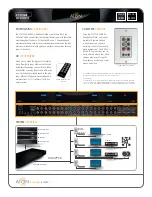
3 Hardware Description
3.3 RS422/485 Electrical Configuration
In typical RS 422 and RS 485 installations certain electric conditions have to be configured. Simply
connecting cables is not enough to fulfill the specifications of RS 422 and RS 485.
For ease of installations the NetCom Plus Serial Device Servers provide the function for often used
Termination. This is activated by selecting the appropriate line operation mode via DIP Switches
(table
15
) or by software.
The electrical properties of USB–COM Plus serial ports are identical.
3.3.1 Termination Resistors
The use of long communication lines in RS 422 and RS 485 mode requires the installation of ter-
mination resistors. These must match the impedance of the cable. Typical cables in Twisted-Pair
configuration have an impedance of about 120Ω. In RS 422 and RS 485 4-wire this resistor has to
be placed at the end(s) far from the sender, in RS 485 2-wire the typical configuration requires one
resistor at each end of the cable.
The NetCom Plus Serial Device Servers provide a suitable termination resistor integrated in the
line drivers, activation is done by selecting the appropriate operation mode.
For values of impedance other than 120Ω the resistors have to be installed directly on the cable.
3.3.2 BIAS Function
RS 485 requires a BIAS option for the communication lines. This will guarantee stable electrical
levels on the cables, even at times when no station is transmitting data. Without BIAS there will
be noise on the cable, and sometimes receivers can not detect the first characters of a beginning
communication.
The NetCom Plus Serial Device Servers do not need an explicit BIAS function. With termination
active the idle state of the transmission line is at 0V, which is recognized as a positive level (logic
one) in the receiver circuit. Other devices may require explicit BIAS for a higher voltage at idle
state, e.g. 100mV. In such situation attach that function directly to the cable.
3.4 Serial Port Simple Settings
There is one set of 4 DIP switches to configure the operation mode of the NetCom Plus Device.
This switch is the Master configuration for each serial port. All ports operate in the same mode,
unless the DIP switches configure for software setting. Before connecting a serial device, the serial
port configuration must be completed.
Warning
: a bad configuration may cause serious damage in the
NetCom
+
or the connected device. To avoid these problems,
it is recommended not to connect a device to the serial ports
in the first installation. The serial ports should be configured
for RS 232. This is done by setting the DIP switches like this
example.
Figure 11: DIP NetCom
Plus
September 2016
NetCom Plus User Manual
24
















































